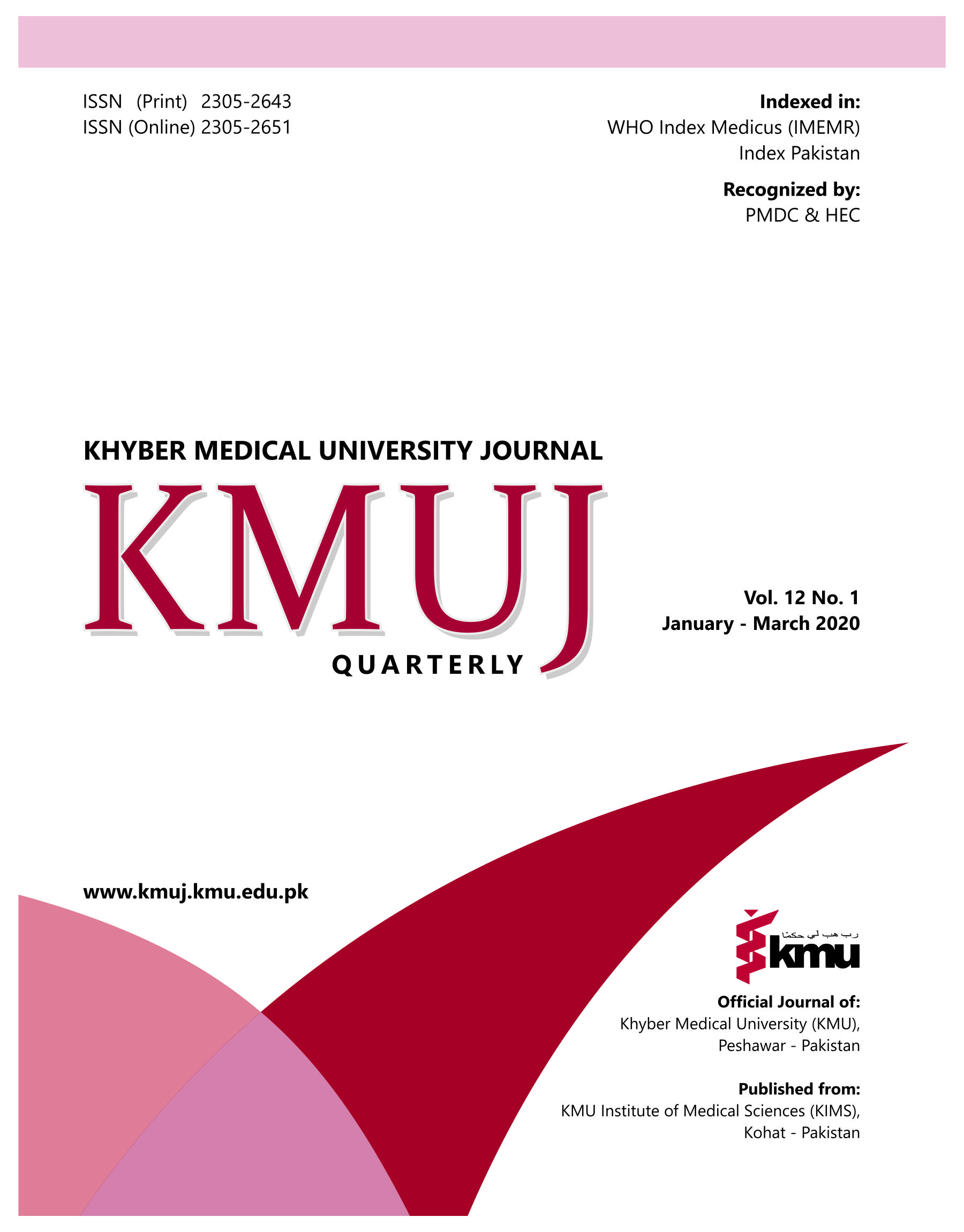ASSOCIATION OF TOOTH LOSS WITH TEMPOROMANDIBULAR DISORDERS
Main Article Content
Abstract
OBJECTIVE: To determine the association of tooth loss with temporomandibular disorders (TMD) in in our local population.
METHODS: This case-control study was carried out in Department of Prosthodontics at Armed Forces Institute of Dentistry, Rawalpindi, Pakistan. A sample size of 285 subjects (95 cases and 190 controls) was enrolled in the study. Anamnestic questionnaire was administered to the patients fulfilling the criteria. Based on the score attained, patients were grouped as TMD patients (case) or TMD free patients (control). A pre-designed performa was used to record the data. SPSS v.17.0 was used for descriptive and inferential analysis.
RESULTS: The mean age of the participants was 33.3±11.2 years with male to female ratio of with 1.26:1. Maximum of the participants (72%) were of 41 years or less. Overall mean number of missing teeth in all participants was 3.41±3.08. Mean number of missing teeth in cases and controls was 4.46±3.65 and 2.89±2.60 respectively (p< 0.001). Tooth loss of <5 teeth & ≥5 teeth was observed in 53 & 42 cases as compared to 128 & 62 controls respectively (OR=0.61; 95% CI: 0.36 to 1.01; p-vale 0.056). The relationship for number of quadrants with number of missing teeth in cases and control groups was significant (p-value=<0.001).
CONCLUSION: Present study indicates that there is significant correlation between the numbers of quadrants with tooth loss and TMD. Increasing the number of quadrants with tooth loss will increase the risk of TMD. However, the number of teeth lost itself has no association with TMD.
Article Details
Work published in KMUJ is licensed under a
Creative Commons Attribution 4.0 License
Authors are permitted and encouraged to post their work online (e.g., in institutional repositories or on their website) prior to and during the submission process, as it can lead to productive exchanges, as well as earlier and greater citation of published work.
(e.g., in institutional repositories or on their website) prior to and during the submission process, as it can lead to productive exchanges, as well as earlier and greater citation of published work.
References
Balasubramaniam R, Delcanhol R. Temporomandibular disorders and related headache. In: Selvaratnam P, Niere KR, Zuluaga MI, Oddy P (eds). Headache, Orofacial Pain and Bruxism - Diagnosis and multidisciplinary approaches to management. 2009;pp69-82. Churchill Livingstone, Elsevier, UK.
Bonjardim LR, Lopes-Filho RJ, Amado G, Albuquerque RL, Goncalves SR. Association between symptoms of temporomandibular disorders and gender, morphological occlusion, and psychological factors in a group of university students. Indian J Dent Res 2009;20(2):190-4. DOI: 10.4103/0970-9290.52901.
Oral K, Bal Küçük B, Ebeoğlu B, Dinçer S. Etiology of temporomandibular disorder pain. Agri 2009;21(3):89-94.
Mundt T, Mack F, Schwahn C, Bernhardt O, Kocher T, John U, et al. Gender Differences in Associations between Occlusal Support and Signs of Temporomandibular disorders: Results of the Population-Based Study of Health in Pomerania (SHIP). Int J Prosthodont 2005;18(3):232-9.
Wang MQ, Xue F, He JJ, Chen JH, Chen CS, Raustia A. Missing posterior teeth and risk of temporomandibular disorders. J Dent Res 2009;88(10):942-5. DOI: 10.1177/0022034509344387.
Dulcic N, Panduric J, Kraljevic S, Badel T, Celic R. Incidence of Temporomandibular Disorders at Tooth Loss in the Supporting Zones. Coll Antropol 2003;27(Suppl 2):61–6.
Witter DJ, Kreulen CM, Mulder J, Creugers NH. Signs and symptoms related to temporomandibular disorders--Follow-up of subjects with shortened and complete dental arches. J Dent 2007;35(6):521-7. DOI: 10.1016/j.jdent.2007.02.003.
Conti PC, Ferreira PM, Pegoraro LF, Conti JV, Salvador MC. A cross-sectional study of prevalence and etiology of signs and symptoms of temporomandibular disorders in high school and university students. J Orofac Pain 1996;10(3):254-62.
Molin C. From bite to mind: TMD--a personal and literature review. Int J Prosthodont 1999;12(3):279-88.
Hylander WL. The human mandible: lever or link? Am J Phys Anthropol 1975;43(2):227-42. DOI: 10.1002/ajpa.1330430209.
Sheridan SG, Mittler DM, Van Gerven DP, Covert HH. Biomechanical association of dental and temporomandibular pathology in a medieval Nubian population. Am J Phys Anthropol 1991;85(2):201-205. DOI: 10.1002/ajpa.1330850208.
Khan MF, Gull S, Chatha MR. Temporomandibular Disorders. Pak Oral Dental J Dec 2011;31(2):266-72.
Cooper BC; International College of Cranio-Mandibular Orthopedics (ICCMO). Temporomandibular disorders: A position paper of the International College of Cranio-Mandibular Orthopedics (ICCMO). Cranio 2011;29(3):237-44. DOI: 10.1179/crn.2011.034.
Pullinger AG, Seligman DA. Quantification and validation of predictive values of occlusal variables in temporomandibular disorders using a multifactorial analysis. J Prosth Dent 2000;83(1):66-75. DOI: 10.1016/s0022-3913(00)70090-4.
Chairunnisa R, Sihombing RJ. The Association between Number of Tooth Loss, Tooth Loss Quadrants, and Occlusal Support with Temporomandibular Disorders in Partially Edentulous Patients. Adv Health Sci Res 2017;8:255-8. DOI: 10.2991/idcsu-17.2018.65.
Manchikalapudi G, Polasani LR. Correlation between posterior edentulousness and temporomandibular disorder in adult population: A case control study. Int Arch Integr Med 2017;4(10): 143-150.
Luder HU. Factors affecting degeneration in human temporomandibular joints as assessed histologically. Eur J Oral Sci 2002;110(2):106-13. DOI: 10.1034/j.1600-0722.2002.11212.x.
Whittaker DK, Davies G, Brown M. Tooth loss, attrition and temporomandibular joint changes in a Romano-British population. J Oral Rehabil 1985;12(5):407-19. DOI: 10.1111/j.1365-2842.1985.tb01546.x.
Christensen LV, Ziebert GJ. Effects of experimental loss of teeth on the temporomandibular joint. J Oral Rehabil 1986;13(6):587-98. DOI: 10.1111/j.1365-2842.1986.tb00682.x.
Tallents RH, Macher DJ, Kyrkanides S, Katzberg RW, Moss ME. Prevalence of missing posterior teeth and intraarticular temporomandibular disorders. J Prosthet Dent 2002;87(1):45-50. DOI: 10.1067/mpr.2002.121487.
Kanno T, Carlsson GE. A review of the shortened dental arch concept focusing on the work by the Käyser/Nijmegen group. J Oral Rehabil 2006;33(11):850-62. DOI: 10.1111/j.1365-2842.2006.01625.x.
Holmlund A, Axelsson S. Temporomandibular joint osteoarthrosis. Correlation of clinical and arthroscopic findings with degree of molar support. Acta Odontol Scand 1994;52(4):214-8. DOI: 10.3109/00016359409029049.
Sarita PT, Kreulen CM, Witter D, Creugers NH. Signs and symptoms associated with TMD in adults with shortened dental arches. Int J Prosthodont 2003;16(3):265-70.
